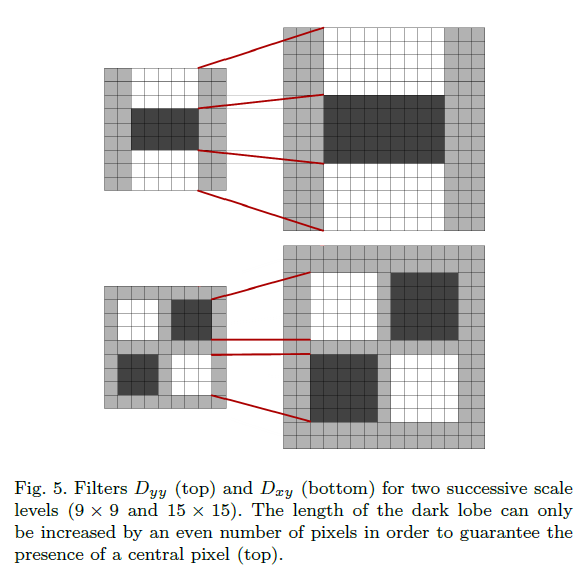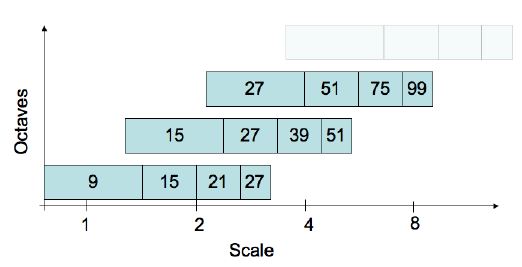So, I was reading the paper on SURF (Bay, Ess, Tuytelaars, Van Gool: Speeded-Up Robust Features (SURF)) and I can not comprehend this paragraph below:
Due to the use of box filters and integral images, we do not have to iteratively apply the same filter to the output of a previously filtered layer, but instead can apply box filters of any size at exactly the same speed directly on the original image and even in parallel (although the latter is not exploited here). Therefore, the scale space is analysed by up-scaling the filter size rather than iteratively reducing the image size, figure 4.
This is figure 4 in question.

PS: The paper has an explanation of integral image, however the whole content of the paper is based on the particular paragraph above. If anybody has read this paper, can you briefly mention what is going on here. The whole mathematical explanation is quite intricate to have a good grasp first up, so I need some assistance. Thanks.
Edit,couple of issues:
1.
Each octave is subdivided into a constant number of scale levels. Due to the discrete nature of integral images, the minimum scale difference between 2 subsequent scales depends on the length lo of the positive or negative lobes of the partial second order derivative in the direction of derivation (x or y), which is set to a third of the filter size length. For the 9x9 filter, this length lo is 3. For two successive levels, we must increase this size by a minimum of 2 pixels (one pixel on every side) in order to keep the size uneven and thus ensure the presence of the central pixel. This results in a total increase of the mask size by 6 pixels (see figure 5).
Figure 5

I could not make sense of the lines in the given context.
For two successive levels, we must increase this size by a minimum of 2 pixels (one pixel on every side) in order to keep the size uneven and thus ensure the presence of the central pixel.
I know they are trying to do something with the length of the image, if its even they are trying to make it odd, so that there is a central pixel which will enable them to calculate the maximum or the minimum of the pixel gradient. I am bit iffy about its contextual meaning.
2.
In order to calculate descriptor Haar wavelet is used.

How is the middle region has low $\sum\ dx$ but high $\sum\ |dx|$.
3.

What is the necessity of having an approximate filter?
4. I have no issue with the way that they found out the size of the filter. They "did" something empirically. However, I have some nagging issue with this piece of line
The output of the 9x9 filter, introduced in the previous section, is considered as the initial scale layer, to which we will refer as scale s = 1.2 (approximating Gaussian derivatives with σ= 1.2).
How did they found out about the value of σ . Moreover how does the calculation of scaling done shown in the image below.The reason I am stating about this image is that the value of s=1.2 keeps on recurring, without clearly stating about its origin.

5.
The Hessian Matrix represented in terms of L which is the convolution of second order gradient of Gausssian filter and the image.

However the "approximated" determinant is said to contain only terms involving second order Gaussian filter.

The value of w is:

My question why the determinant is calculated like that above, and what is the relationship between approximate Hessian and Hessian matrix.
